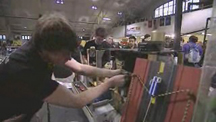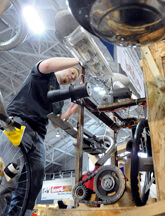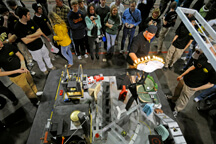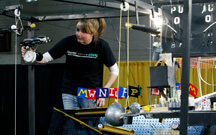
| VIDEO |
 * University of Illinois team pulls off upset in regional Rube Goldberg competition at Purdue. (3 minutes, 10 seconds) * University of Illinois team pulls off upset in regional Rube Goldberg competition at Purdue. (3 minutes, 10 seconds) |
| RELATED INFO |
| * Rube Goldberg Contest at Purdue |

February 21, 2009
Illinois team wins regional Rube Goldberg contest
WEST LAFAYETTE, Ind. - |
The Illinois team now advances to the national competition March 28 at Purdue.
The competition, sponsored by Phi Chapter of Theta Tau fraternity, rewards machines that most effectively combine creativity with inefficiency and complexity. The task this year was to build a machine that would utilize a minimum of 20 steps to replace an incandescent light bulb with a more energy-efficient, light-emitting design.
The Illinois Rube Goldberg Society, made up of students from the University of Illinois at Urbana-Champaign, built a machine based on the board game Clue called Scene of the Crime. It followed various characters that were "murdered" along the way in various rooms. The machine featured dice, lead pipes, dominos, a plant that "grows," a magnet and a gripping mechanism that unscrewed an incandescent bulb and screwed in a compact fluorescent bulb. The team used 70 steps to complete the task.
James Kryger, team captain and a sophomore in engineering physics, said the team came up with the Clue idea early on, then built a machine around the concept. They began building the machine in early November.
Kryger said that although it was the first time the team has competed in Rube Goldberg, they felt confident because he and other members had experience with the high school competition. Kryger, of Park Ridge, Ill., was a member of the Maine South High School Rube Goldberg team for two years, capturing the 2006 Illinois state title.
"Coming into the competition, we were a little nervous, but we were very excited to be here for the first time," Kryger said. "We were very pleased with our two perfect runs and are excited to come back to Purdue next month for the national contest."
The teams had three tries to make two successful runs, and points were deducted if students had to assist the machine once it had started.
 |
The Garage Junkies, a new team this year, placed second. It was made up of four students majoring in mechanical engineering technology and one majoring in mechanical engineering who are self-proclaimed car buffs. Their machine consisted almost solely of parts from vintage cars that they work on, such as a 1967 Ford Mustang emblem, headlights from a Model A and various other parts dating back to the 1930s and 1940s. The team completed the task in 46 steps, culminating in the Model A standard headlights flipping over to reveal headlights made from LEDs.
"It's amazing," said Garage Junkies team member Austin Lucas, a senior in mechanical engineering from Fremont, Ind. "We just wanted to come here and have a good time. This is definitely a complete shock."
Blair Conner, regional contest chairman and a junior in electrical engineering technology from St. Charles, Ill., said: "It was an especially exciting competition with an out-of-state team and a team not associated with an organization winning first and second."
 |
Third place went to the Purdue Society of Professional Engineers, which had won the regional competition the previous four years. The team's theme was Las Vegas Blackout. In 101 steps, a pilot crashes into the old Las Vegas sign and eventually lights a new, more efficient sign.
"Our team is proud of its accomplishments," said Society of Professional Engineers member Michael Keefer, a junior in civil engineering from Fort Wayne, Ind. "The Illinois team had a really nice machine, and they were good sports."
Other teams competing were from the Purdue National Society of Black Engineers, Society of Women Engineers and American Society of Mechanical Engineers, and a team from Washington State Community College in Ohio.
Also taking place on Saturday (Feb. 21) at Purdue was the regional high school Rube Goldberg Machine Contest. Highland Senior High School, Anderson, Ind., placed first and will advance to the national high school competition March 28 at Purdue. Placing second was Owen Valley Community High School, Spencer, Ind., and Brebeuf Jesuit Preparatory School, Indianapolis, came in third.
 |
The competition pays homage to the late cartoonist Rube Goldberg, who specialized in drawing whimsical machines with complex mechanisms to perform simple tasks. Goldberg earned a degree in engineering from the university of California, Berkeley, in 1904. He worked as an engineer for the city of San Francisco for less than a year before becoming a sports cartoonist for the San Francisco Chronicle. He received a Pulitzer Prize in 1948 for his political cartoons published by the New York Sun.
Sponsors for this year's event were BAE Systems, Bose, BP, Lockheed Martin, Lutron Electronics, Motorola, Omega Engineering, Priio, Rockwell Collins, the Purdue School of Mechanical Engineering and the College of Technology.Writer: Judith Barra Austin, (765) 494-2432, jbaustin@purdue.edu
Sources: Blair Conner, regional contest chairman, (630) 677-7333, brconner@purdue.edu
Mike Mierzwa, Theta Tau national contest chairman, (201) 563-5071, mmierzwa@purdue.edu
Melissa Weddle, president of the Society of Women Engineers, (812) 821-1956, mweddle@purdue.edu
Purdue News Service: (765) 494-2096; purduenews@purdue.edu
PHOTO CAPTION:
James Kryger, captain of the University of Illinois at Champaign-Urbana team, drops a marble to start his team's machine during the regional Rube Goldberg Machine Competition on Saturday (Feb. 21) at the Purdue University Armory in West Lafayette. Kryger's team placed first and will advance to the national competition on March 28 at Purdue. The goal of this year's competition was to replace an incandescent light bulb with a more energy-efficient, light-emitting design. (Purdue News Service photo/Andrew Hancock)
A publication-quality photo is available at https://www.purdue.edu/uns/images/+2009/rubegoldberg4.jpg
PHOTO CAPTION:
Jacob Adams of Purdue's Garage Junkies team prepares his team's machine during the regional Rube Goldberg Machine Competition on Saturday (Feb. 21) at the Purdue University Armory in West Lafayette. The team placed second in the contest. The goal of this year's competition was to replace an incandescent light bulb with a more energy-efficient, light-emitting design. (Purdue News Service photo/Andrew Hancock)
A publication-quality photo is available at https://www.purdue.edu/uns/images/+2009/rubegoldberg1.jpg
PHOTO CAPTION:
Zach Umperovitch of the Purdue Society of Professional Engineers team displays his team's machine during the regional Rube Goldberg Machine Competition on Saturday (Feb. 21) at the Purdue University Armory in West Lafayette. The goal of this year's competition was to replace an incandescent light bulb with a more energy-efficient, light-emitting design. (Purdue News Service photo/Andrew Hancock)
A publication-quality photo is available at https://www.purdue.edu/uns/images/+2009/rubegoldberg2.jpg
PHOTO CAPTION:
Olivia Bozik of the Purdue Society of Women Engineers team starts her team's machine during the regional Rube Goldberg Machine Competition on Saturday (Feb. 21) at the Purdue University Armory in West Lafayette. The goal of this year's competition was to replace an incandescent light bulb with a more energy-efficient, light-emitting design. (Purdue News Service photo/Andrew Hancock)
A publication-quality photo is available at https://www.purdue.edu/uns/images/+2009/rubegoldberg3.jpg
To the News Service home page
